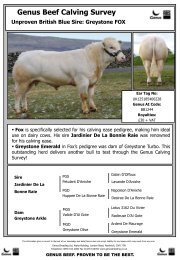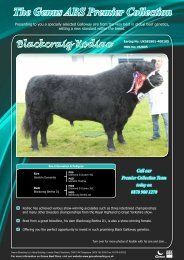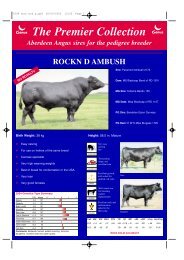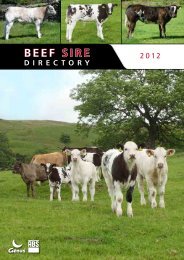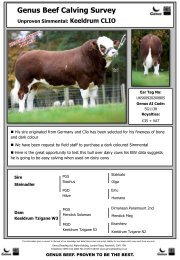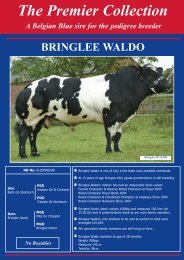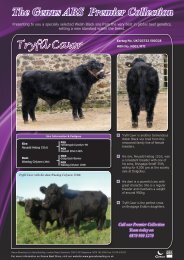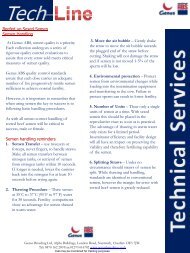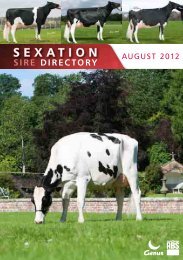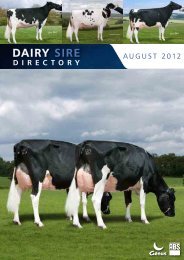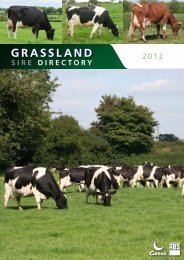BEEF SEXATION - Genus UK website
BEEF SEXATION - Genus UK website
BEEF SEXATION - Genus UK website
Create successful ePaper yourself
Turn your PDF publications into a flip-book with our unique Google optimized e-Paper software.
<strong>BEEF</strong> <strong>SEXATION</strong><br />
An on-farm guide to<br />
sexed beef semen<br />
Helping to create your<br />
ideal suckler cow
SEXED <strong>BEEF</strong> SEMEN<br />
WHAT DOES IT OFFER<br />
INVESTIGATING CALVING<br />
AT TWO YEARS OF AGE<br />
Within recent years, there has been increasing<br />
interest by suckler farmers to breed their<br />
own herd replacements.<br />
This is mainly due to the poor and variable<br />
quality of stock available to purchase and the<br />
bio-security risk associated with purchasing<br />
animals of unknown disease status.<br />
A POTENTIAL MANAGEMENT SOLUTION<br />
Replacement heifers are the life blood of every<br />
beef suckler herd, as these animals provide<br />
the opportunity to drive productivity through<br />
genetic improvement, long term. These animals<br />
deserve considerable attention to ensure they<br />
reach their full potential performance and this<br />
can be achieved through the use of quality<br />
genetics via sexed beef semen.<br />
THE BENEFITS OF USING GENUS ABS AI<br />
AND SEXED <strong>BEEF</strong> SEMEN<br />
• Opportunity to create 90% females from AI<br />
(90% female sperm in each straw).<br />
• Calving ease of heifer calves born from<br />
<strong>Genus</strong> ABS selected sires with short<br />
gestation length and appropriate calving<br />
ease, both directly and in their daughters.<br />
• Greater opportunity to calve at 24 months,<br />
due to potential calving ease of a heifer<br />
calf.<br />
• Efficiently increases herd size.<br />
• More animals for pregnancy to a terminal<br />
sire.<br />
•<br />
Efficiency must be considered when assessing<br />
suckler cow and heifer performance. Many<br />
farms are now considering the option of<br />
breeding their own replacements.<br />
With the desire to rear and breed your own<br />
heifers, it has to be remembered that the heifers<br />
must calf down at either two or three years of<br />
age if a consistent, single calving period is to be<br />
maintained. <strong>Genus</strong> ABS sexed beef semen is the<br />
perfect option to help with this process.<br />
CALVING AT TWO YEARS, THE ADVANTAGES<br />
• Improved efficiency of production.<br />
• Reduced investment in resources due<br />
to fewer animals. Land and feed etc,<br />
approximately 15%.<br />
• Faster return on investment, increased<br />
carcass output per ha.<br />
• Genetic progress is more rapid.<br />
• Reduction in green house gas emissions<br />
(10-15%).<br />
KEY PRINCIPLES TO CALVING A TWO YEAR OLD HEIFER...<br />
1 Select heifer calves for Calculate mature cow<br />
breeding from the most weight on farm and<br />
fertile cows in the herd. manage the heifers to<br />
achieve at least 65% of<br />
this mature weight at<br />
the start of the breeding<br />
season.<br />
2 3 Heifers are more likely to be cycling regularly<br />
4<br />
if they have reached 65% of their mature<br />
weight (mature cows weight 650kg, bulling<br />
weight at 14/15 months of 420kg, 90% of<br />
mature weight at calving of 585kg) and are<br />
more likely to give better results with sex<br />
sorted semen and calve sooner in the season.<br />
Select top AI sires from <strong>Genus</strong> ABS with careful<br />
attention being placed on calving ease, low<br />
birth weight and short gestation length.<br />
Consider using <strong>Genus</strong> ABS sexed beef semen.<br />
• Breed own heifers and create a closed<br />
herd.<br />
• Reduce disease risk from purchased<br />
females.<br />
• Increases control over replacement costs.<br />
5<br />
Heifers can be synchronised<br />
using many different<br />
programmes, so that<br />
labour requirements<br />
for heat detection and<br />
supervision of calving, is<br />
minimised. Consult with<br />
your veterinary surgeon.<br />
6 Aim to calve down heifers<br />
at least two weeks before<br />
the main herd, to allow<br />
extra attention to be<br />
devoted to them.<br />
7<br />
Consult your vet for suitable synchronisation<br />
programmes, especially if considering<br />
using <strong>Genus</strong> ABS sexed beef semen (not a<br />
recommended practice with sorted semen).<br />
1 2
the SCIENCE BEHIND<br />
the sorting process<br />
conventional v’s sexed<br />
what’s achievable<br />
Sexed semen goes through a flow cytometry<br />
sorting process to sort X (female) from Y<br />
(male) bearing cells, based on the gender<br />
preference of the beef producer.<br />
The procedure using the flow cytometer was<br />
first studied in the 1980’s. Then in the 1990’s,<br />
the first calf using this procedure was born and<br />
since then, research has been carried out to<br />
increase the efficiencies of the semen sorting<br />
technique.<br />
This opportunity allows producers to select<br />
progeny gender and also allow producers to<br />
choose from the globally recognised <strong>Genus</strong> ABS<br />
product offering.<br />
HOW THE CYTOMETERS SORT THE SEMEN<br />
The female (X bearing chromosome) is a<br />
heavier, more dense chromosome containing<br />
3-4% more DNA than its male counterpart (Y<br />
bearing chromosome), and this is how the cells<br />
are differentiated from each other.<br />
DIAGRAM ONE:<br />
THE SEMEN SORTING PROCESS<br />
The extra process required to produce<br />
any sexed semen product means that<br />
sperm quality is often compromised<br />
and the chances of a successful<br />
pregnancy therefore reduced.<br />
At <strong>Genus</strong> ABS you can rest assured<br />
that we have top scientists working to<br />
optimise bull production schedules,<br />
freezing techniques and sperm quality<br />
checks to ensure the best possible chance<br />
of success.<br />
The steps outlined below ensure that the<br />
ABS Sexation system limits any negative<br />
impact associated with sexed semen.<br />
Our approach will give your heifers the<br />
best possible chance of producing your<br />
next generation of heifers.<br />
It must be noted that conception rates to<br />
sexed semen when used on heifers could<br />
be approximately 75-90% of that which<br />
would be achieved with conventional<br />
beef semen. Likewise, there would also<br />
be a reduction in conception rates if<br />
used on cows.<br />
GRAPH ONE:<br />
nUMBER OF HEIFERS EXPECTED IN 20 CALVINGS<br />
ABS <strong>SEXATION</strong> V’S CONVENTIONAL SEMEN<br />
30%<br />
25%<br />
20%<br />
15%<br />
10%<br />
5%<br />
15%<br />
12%<br />
9%<br />
0<br />
GRAPH TWO:<br />
nUMBER OF HEIFERS EXPECTED IN 100 CALVINGS<br />
ABS <strong>SEXATION</strong> V’S CONVENTIONAL SEMEN<br />
The first step in the procedure is to dilute and stain<br />
the sperm with a fluorescent dye. The sample is<br />
then passed through the cytometer. When the<br />
sperm is passing through the cytometer a laser<br />
beam is placed onto the sperm which in turn<br />
excites the dye stained sperm. Due to the larger<br />
X chromosomes, female sperm emit slightly<br />
more fluorescence than the Y chromosome<br />
bearing sperm. Charged deflector plates then<br />
split the single stream into two streams giving<br />
the desired high purity that you expect:<br />
For example, in a herd achieving an<br />
average conception rate of 70% to<br />
conventional semen, a conception rate<br />
of 53-63% could be achieved by using<br />
sexed semen.<br />
THE HIGHEST STANDARD OF BULL<br />
SELECTION<br />
• All sires must be proven.<br />
6%<br />
3%<br />
0<br />
1. Positively charged particles containing one<br />
sex go one way.<br />
2. Negatively charged and uncharged<br />
particles containing the opposite sex or<br />
multiple sperm go another way (waste).<br />
In a female sorting procedure, unidentified or<br />
multiple sperm and male sperm are discarded.<br />
• All sires must meet the high genetic<br />
standard required by all <strong>Genus</strong> ABS<br />
products.<br />
• All sires must meet all semen quality<br />
and sorted standards applied by<br />
<strong>Genus</strong> ABS.<br />
• All sires must be scientifically proven<br />
to give the best possible chance of<br />
pregnancy.<br />
3 4
TESTIMONIALS<br />
STRAIGHT FROM THE FARM<br />
SYNCHRO PROGRAMMES<br />
FOR <strong>BEEF</strong> HERDS<br />
The Cowan Brothers, Blaencwmpridd, Dyfed...<br />
We were faced with an aging herd and needed to increase the<br />
flow of replacements. Not keen to buy in replacements with<br />
the disease risk being involved, the decision was taken to use<br />
AI and <strong>Genus</strong> ABS sexed beef semen.<br />
AI and sexed semen has allowed us to select bulls with strong<br />
maternal traits. In the first year we used just conventional<br />
semen, but for the last two years we’ve used sexed semen,<br />
which has significantly increased our chances of getting heifers<br />
from heifers.<br />
The system now, is first service to sexed semen. Last year we<br />
achieved 68% conception rate to sexed semen and this year<br />
it was 72%. Second service is to conventional semen and then<br />
we let the bull sweep up so we have a concentrated breeding<br />
The Cowan Brothers<br />
window of six weeks.<br />
This year overall we got 92% in calf to AI which has tightened our heifer calving period and means we<br />
will have a nice even batch of heifers to rear and calve at 24 months of age.<br />
PROGRAMME ONE:<br />
SUCKLER COW SYNCHRONISATION<br />
Progesterone<br />
device<br />
GnRH PGF 2α GnRH TAI<br />
Week<br />
1<br />
7 days 48 hr 16-24 hr<br />
Schedule for PRID/CIDR Sync Protocol<br />
M T W T F S S<br />
GnRH<br />
Progesterone device<br />
GnRH<br />
Week<br />
1<br />
PROGRAMME TWO:<br />
beef heifer synchronisation<br />
Progesterone<br />
device<br />
PGF 2α<br />
5 days 72 hr<br />
GnRH+<br />
TAI<br />
Schedule for Heifer Program<br />
Progesterone device<br />
M T W T F S S<br />
GnRH<br />
Dougie Graham, Mains of Burnbank, Stirling...<br />
I’ve been using artificial insemination across my herd of 100 pure pedigree Limousin cows for the past<br />
two years and have recently started to use sexed semen on my heifers.<br />
There are a couple of reasons for using AI and sexed semen, which are financial benefits of not having to<br />
buy in an expensive stock bull, and the additional profit as a result of breeding better quality stock. Also,<br />
the extra sales of surplus heifers have made quite an impact with one of my first females from sexed<br />
semen having recently sold in Carlisle at the Red Ladies sale for 7000gns, Burnbank Honey.<br />
To date conception rate results to sexed semen have been more than pleasing, achieving a 93% CR<br />
(15/16) on my first group of heifers. I think more farmers are starting to realise the benefits of artificial<br />
insemination. Sexed semen has a big part to play as it not only enhances the chance of getting a heifer<br />
calf, but you are also getting the opportunity to breed in your ideal cow. There is also the huge potential<br />
benefit of calving ease with a heifer calf, as heifers calving down bull calves are more prone to calving<br />
difficulties. There’s nothing more satisfying than not having to intervene at any calving, nevermind a<br />
heifer, and if we do need to intervene were off to a good start.<br />
Week<br />
2<br />
M T W T F S S<br />
PGF 2α<br />
48 hr<br />
GnRH<br />
TAI<br />
16-24 hr<br />
Note: The majority of animals do NOT show heat<br />
KEY FOR ABOVE SYNCHRO PROGRAMMES:<br />
GnRH - Ovarelin ® , Receptal ® , Fertagyl ®<br />
PGF 2α - Estrumate ® , Lutalyse ® , Enzoprost ®<br />
Progesterone Device - Prid®, Cidr®<br />
All of the above are classified as POM-V.<br />
Week<br />
2<br />
GENUS ABS SEXED <strong>BEEF</strong> SEMEN ON FARM RESULTS TO DATE<br />
M T W T F S S<br />
GnRH+<br />
PGF 2α<br />
TAI<br />
Note: The majority of animals do NOT show heat<br />
Please note:<br />
These are examples of brands used, other products are available.<br />
Always consult with your vet regarding the use of these products.<br />
They should only be used following veterinary guidance and supervision.<br />
Tom Cox, Bleaklow Charolais, Derbyshire...<br />
<strong>Genus</strong> ABS sexed beef semen has offered me the<br />
opportunity to retain the best bloodlines in my herd<br />
and increase the speed of my genetic gain.<br />
A high genetic easy calving bull from <strong>Genus</strong> ABS<br />
became available sexed which I used in my pedigree<br />
Charolais herd with great success, achieving a 78%<br />
conception rate.<br />
Moving forward I would be more than happy to use<br />
sexed semen on my breeding heifers and best cows.<br />
This has allowed me to breed females of a higher<br />
genetic merit and ultimately have more heifer calves<br />
to retain as breeding stock from the best maternal<br />
lines, while still allowing me to retain my high herd<br />
health status.<br />
Tom Cox<br />
Figures below were collected through a <strong>Genus</strong><br />
ABS customer survey, January 2013. They show<br />
the conception rate results acheived by using<br />
<strong>Genus</strong> ABS sexed beef semen.<br />
No. of<br />
inseminations<br />
surveyed<br />
267<br />
No. of<br />
pregnancies<br />
No. not<br />
pregnant<br />
Of the 267 insemination results collected,<br />
the average conception rate to <strong>Genus</strong> ABS<br />
sexed beef semen was 61%.<br />
The dots plotted on the map indicate<br />
the locations of the farms surveyed.<br />
Conception<br />
rate<br />
162 105 61%<br />
5 6
The best chance<br />
to achiEve pregnancies<br />
HEAT DETECTION<br />
THE BEST PRACTICE<br />
For the best possible results, we recommend<br />
the use of ABS Sexation on heifers. However,<br />
due to the increasing amount of suckler<br />
farmers in the country now interested in<br />
breeding their own replacements, we’ve<br />
had more enquiries than ever with regard<br />
to using sexed beef semen on their main<br />
breeding herd.<br />
Below, John Cook, <strong>Genus</strong> ABS’ <strong>UK</strong> Technical<br />
Director, gives his recommendations.<br />
• Stick rigidly to thawing times, temperatures<br />
and handling recommendations.<br />
• ABS Sexation should only be considered for<br />
use on heifers and young cows.<br />
• The group in which the chosen animal is<br />
kept should never be stocked above 100%<br />
and preferably less.<br />
• There should be at least two cycles (heats)<br />
observed prior to planned AI at 18-24 day<br />
intervals on the chosen animal.<br />
• Avoid animals with any incident of<br />
postnatal disease in the current lactation.<br />
Accurate heat detection, correct timing of<br />
insemination and minimal stress at serving<br />
are critical when inseminating with sexed<br />
beef semen.<br />
HEAT OBSERVATION GUIDELINES...<br />
1. Observe animals for standing heat at<br />
least 2-3 times daily, for a minimum of 30<br />
minutes.<br />
2. Observations should preferably take<br />
place outside routine tasks i.e. not during<br />
feeding, bedding or scraping out.<br />
3. Record standing heats accurately to verify<br />
regular oestrus cycle length. Animals with<br />
abnormal cycle lengths will be less fertile.<br />
4. If not confident with the use of AI, then<br />
<strong>Genus</strong> ABS Technicians are available to<br />
carry out the inseminations within your<br />
herd.<br />
5. Heat detection aids, such as bulling<br />
beacons, will prove useful in identifying<br />
animals in heat.<br />
6. It is recommended that you should only<br />
use sexed beef semen where natural heats<br />
have been observed. However, it can be<br />
used along with a suitable synchronisation<br />
programme if co-ordinated properly with<br />
assistance from your vet.<br />
7. Consult your vet before choosing a<br />
synchronisation programme with the use<br />
of sexed beef semen.<br />
8. Fixed or timed AI should only be used<br />
in conjunction with synchronisation<br />
programmes designed to synchronise<br />
ovulation, contact your vet for advice on<br />
suitable programmes.<br />
• If being used on young cows, the cow<br />
should be between 70-120 days calved at<br />
the time of service.<br />
• There should not be any case of mastitis in<br />
the cows current lactation.<br />
Semen thawer<br />
• The cows fitness should be of a high<br />
current state (ie. good locomotion and<br />
appropriate BCS).<br />
• Dietary changes should be limited in the<br />
six weeks pre and post insemination of the<br />
heifer.<br />
• There should not be any management<br />
group changes six weeks prior to AI and<br />
until confirmed pregnant at 35-45+ days.<br />
• If unsure on AI technique, use a professional<br />
<strong>Genus</strong> ABS AI Technician.<br />
7<br />
8
HIGH STANDARDS<br />
CRUCIAL TO SUCCESS<br />
The IMPORTANCE OF<br />
ai technique<br />
At <strong>Genus</strong> ABS, semen quality is a priority,<br />
undergoing a series of rigorous quality<br />
control evaluations.<br />
However, it is important to remember that when<br />
using semen the key to success is to following<br />
basic handling procedures. As with all semen,<br />
correct handling of sexed beef semen will be<br />
vital to success, male or female.<br />
SEMEN HANDLING REMINDERS...<br />
1. Semen transfer – use tweezers or forceps,<br />
never fingers, to handle straws. Make all<br />
semen transfers between nitrogen tanks,<br />
or retrieval of semen from nitrogen tanks,<br />
within 10 seconds. If longer is needed,<br />
lower the canister back into the nitrogen<br />
for at least 10 seconds before trying again.<br />
2. Thawing procedure – thaw semen at<br />
35˚C to 37˚C (95˚F to 97˚F) water for<br />
30 seconds. Fertility comparisons show<br />
an advantage for semen thawed in warm<br />
water.<br />
Semen handling<br />
THE SERVICE PERIOD...<br />
1. Steps should be taken to ensure that<br />
inseminations are as stress free and accurate<br />
as possible.<br />
2. Animals should be suitably restrained so<br />
they cannot move forwards, backwards or<br />
sideward’s. A proper service area or crush<br />
is ideal.<br />
3. Animals put forward for service should be<br />
moved quietly to the service area and kept<br />
in pairs or in small groups, to reduce stress.<br />
4. We strongly advise that insemination of<br />
<strong>Genus</strong> ABS sexed beef semen is carried out<br />
by a competent DIY Technician or a <strong>Genus</strong><br />
ABS Technician.<br />
5. Due to the processing required to sex semen,<br />
sorted semen is more susceptible to damage<br />
than conventional semen, the highest<br />
standards of handling and insemination are<br />
vital to its success.<br />
3. Move the air bubble – gently shake the<br />
straw to move the air bubble towards the<br />
plugged end of the straw before cutting.<br />
Shaking will not damage the straw and if<br />
semen is not moved, 1-5% of the sperm<br />
will be lost.<br />
4. Environmental protection – protect<br />
semen from environmental changes while<br />
loading into the insemination equipment<br />
and transferring to the cow. Failure to<br />
protect sperm can result in lower fertility.<br />
AI gun being loaded<br />
5. Number of units – thaw only one single<br />
unit of semen at a time. With sexed semen<br />
this should be placed in the reproductive<br />
tract as soon as it is practical. The<br />
advantage of thawing in warm water only<br />
exists for a limited period. Inseminator<br />
efficiency and facility design will all have<br />
an impact on preserving the viability<br />
and therefore fertilising capability of the<br />
semen.<br />
9<br />
6. Splitting straws – under no circumstances<br />
should straws of semen be split. While<br />
thawing and handling, standards are<br />
identical to conventional semen, the<br />
margin for error with sorted beef semen<br />
is greatly reduced.<br />
Semen timer<br />
10
<strong>BEEF</strong> <strong>SEXATION</strong><br />
Helping to create your ideal<br />
suckler cow<br />
For more information on sexed beef semen, contact us on:<br />
Tel No: 0870 162 2000<br />
<strong>Genus</strong> Breeding Ltd, Alpha Building, London Road, Nantwich, CW5 7JW<br />
Tel: 0870 162 2000 Fax: 01270 616702 www.genusbreeding.co.uk<br />
Calls may be monitored for training purposes.



